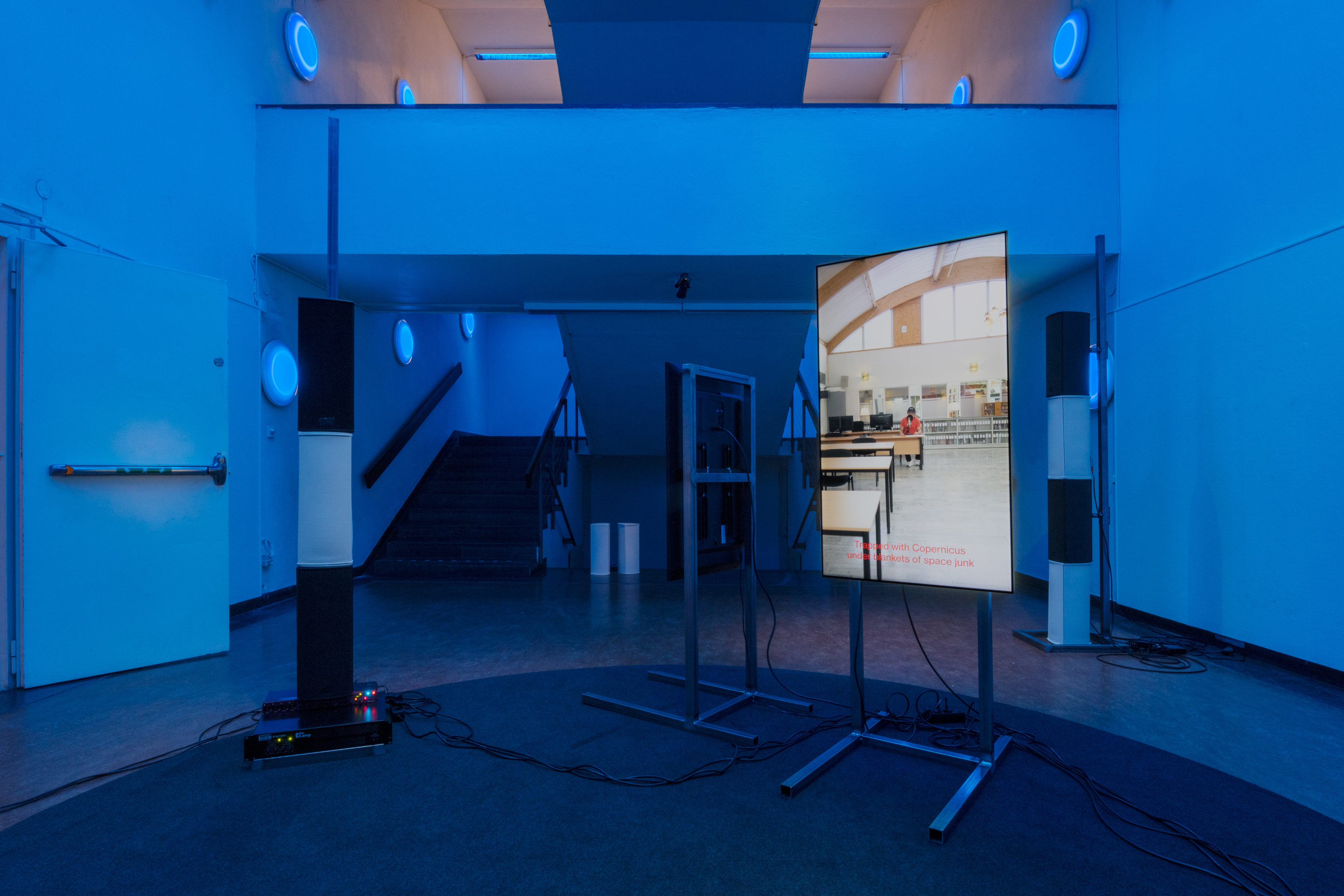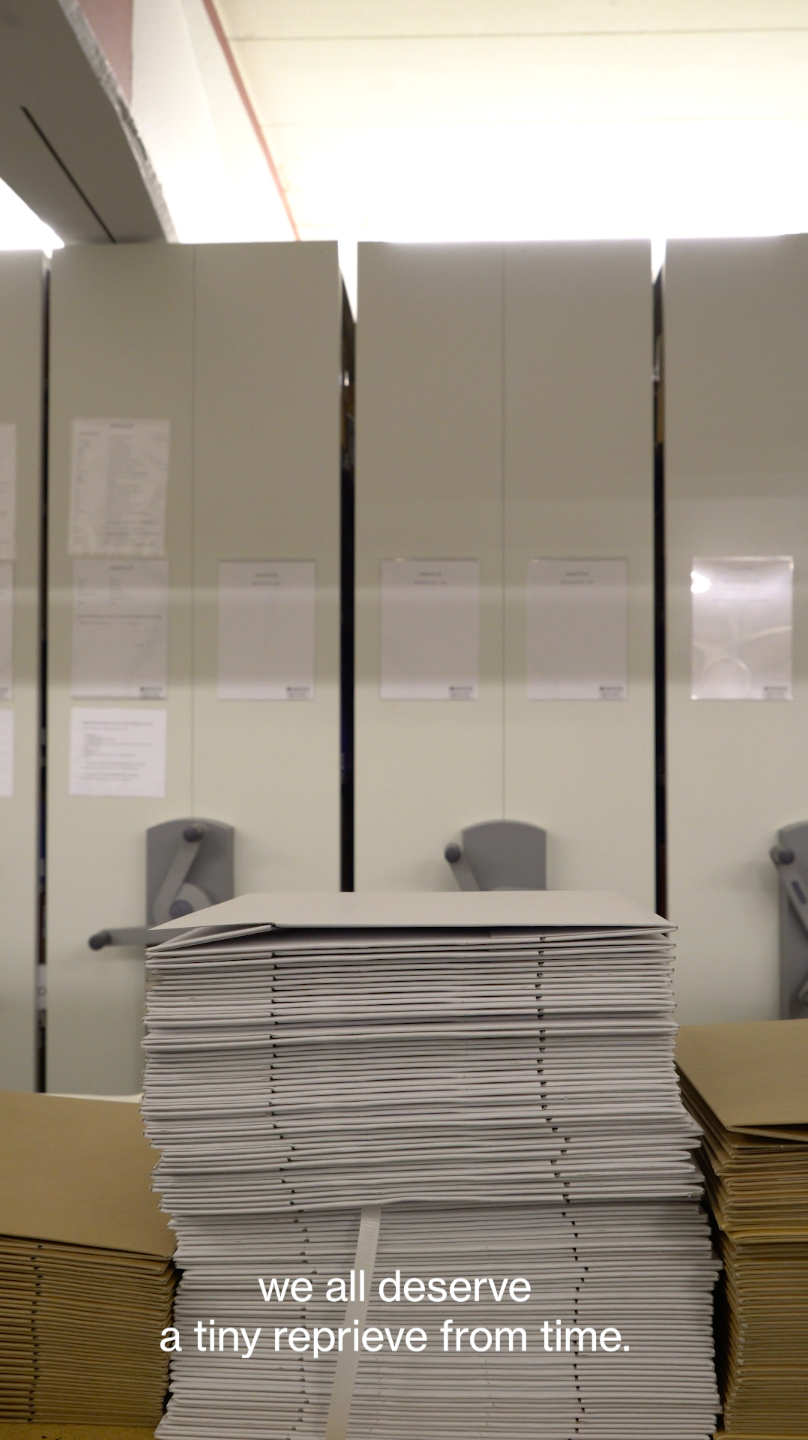Armin Lorenz Gerold: The city unfolds in sound
By using text, alongside sculpture, video, and installation Armin Lorenz Gerold seeks not just to make sound visible, but to forge a different kind of image.
Armin Lorenz Gerold tells me the story of how he met our mutual friend Reece Cox, who messaged him on Instagram asking for permission to use installation images of his recent show at Kunsthalle Graz (AT) for his blog called Nothing To See. Nothing To See documents the “non-visual visual arts” and is, at first sight, a stream of empty white walls and speaker assemblages, which look uncannily humanoid when collected like this. Beneath this humorous take on the fate of the sound artist lies a very real query of how to represent sonic experiences when the art world is dominated by the streamline exhibition reproduction. How to account for the kinds of images that are sonic, virtual, and imagined alongside a narrated story? Gerold (b. 1981 in Graz, Austria) employs sound and text, alongside sculpture, video, and installation to tinker the borders of sight and sound, seeking not just to make sound visible, but forging a different kind of image making all together.

In Autumn 2023, a newly commissioned installation premiered at Stockholm’s non-profit space Mint titled Many Ways to Now. In a two-canal video and twelve-canal sound installation, Armin Lorenz Gerold and artist Mara Lee performatively read ten texts by ten different artists and poets. The mostly static video frames document the audio-recording process, which took place in the Labour Movements Archive of Stockholms Elektronmusikstudion and the Arbetarnas bildningsförbund headquarters (the Workers’ Educational Association), where Mint is also located. The readers are seen seated or standing, often from a distance, connecting the soothing voices to a body. Although there is no specific beginning or end to the two-hour loop, as curator Emily Fahlén reassures me, the opening piece, an excerpt of Anne Boyer’s keynote speech at FORUM: Altered States at Kunstinstituut Melly, Rotterdam, 2021, is also the one that prompted Gerold’s initial thinking. Boyer’s words “Winged things, fragrances, fugitive pigments, flowers act on us in vertical instants, not in the horizontal expansiveness of time” delicately lay down a gradual erosion of the senses amongst capitalism, arguing that the pace and rhythm of contemporary life leave little time for anything non-productive, let alone beautiful (like stopping to smell a flower). From there, Gerold invited contributors to expand on these topics of time and temporality, which seemed especially relevant in a post-pandemic state of unhinged disarray.

I lay on the cushioned floor in the blue-lit room and let Armin Lorenz Gerold’s and Lee’s soothing voices wash over me, taking in the prose of Jay Bernhard, Lori E. Allen, Reece Cox amongst others. I think of how an audio piece works along different temporal registers than, say, looking at a painting. When regarding an image, the whole reveals itself almost instantly, all the shapes and colours in their relation to one another are already there. Gradually, one makes meaning through connecting the dots of its specificities. But when reliant on another’s voice to tell a story, one must wait, patiently, for the image to unfold over time. In his own texts, Gerold crafts this suspense into his narrations, often choosing the most minute of details with which to set his scenes. An audio play titled Temporal Unease, which is one of the texts included at Mint, opens at the end of a long night: “One man holds an almost fully burnt cigarette between two fingers that are resting on another man’s shoulder.” From there the scene expands into what sounds like an afterparty, and the listener is taken along gradually as if only making sense of the situation in real-time with the protagonist on his walk home.

The narratives are enriched through scores, ambient music, and field recordings, from purring cats to echoing footsteps on wet concrete. “I want to paint a picture in sound,” Armin Lorenz Gerold tells me. For somebody like me, whose job it is to look at art, to be stripped of the visual component is at first a slightly daunting proposition. The visual images created while experiencing the work are not fixed, but virtual, as they are contingent on the guidance of a narrator, and most significantly, on the nuances of one’s own imagination. In this context, each listener harbours a unique mental image. One could ask: “How does sound translate into an image?” or as to not espouse the visual: “How might sound feel? What does this sound taste like?”

“People don’t realise that the ear is an extremely potent device” Gerold tells me enthusiastically. In the absence of visual stimuli, the power of sound to evoke a spectrum of sensory perceptions truly comes to life. In 1998 Kodwo Eshun coined the seminal term Sonic Fiction to encapsulate the revolutionary potential inherent to Afrofuturist music. While Eshun wasn’t bothered about scientifically pinning down the term, many have tried to do so since, thrilled by the idea of sonic world-building potential. In his recent book exploring the notion, Holger Schulze asserts: “As soon as you listen, experience, digest or anticipate a given sound event, there are some germs of a sonic fiction planted in your sensory imagination, your reflection and desires. Sonic fiction is sensory sensibility.” It’s true that the affective presence of sounds can relate so strongly to memories, feelings, places. Doesn’t everybody have that one bittersweet song that is almost unbearable to listen to, because somebody who broke your heart once put it on in the car, or in bed after making love? But still, you listen on repeat, as it is the closest you could imaginably get to re-living that moment.
When thinking about the relation of sound to image, or the communication of the senses in general, I find it fitting that Armin Lorenz Gerold tells me that he started out studying photography and already turned to sound for his graduation project. “I was struggling with the representative aspect of photography and the specific codification of images.” He explains: “Sound allowed me to work within the realm of fiction, of what could be possible”. Titled Fogs (2011), the project looked at the disappearance of queer spaces in the aftermath of the AIDS epidemic and comprised of a single photograph as well as four loudspeakers playing a specifically composed sound-piece. By turning away from pure documentation, sound seems to capture a feeling in a way that a photograph just couldn’t. With melodic vocals and an ethereal synth score, the idea was to capture an atmosphere. “Was it possible to convey a mood, or the essence of a space long gone?” Gerold asks. Sound creates space for the potential, the fictional beyond the actual.

Manuel, or a Hint of Evil (2021) sets out to capture the uncanny essence of the early pandemic. Initially conceived as an installation, the project faced an involuntary halt due to the pandemic and ultimately morphed into an audio play performed with Hanne Lippard at Berlin’s Haus der Kulturen der Welt. Over a span of 42 minutes, an unnamed narrator chronicles his daily visits to Berlin’s Olympiabad, an outdoor swimming pool constructed under National Socialist rule, its unchanged architecture to this day evocative of the historic era. “What does it feel like to swim in a Nazi bath during a time when people don’t want to get close to one another?’ Armin Lorenz Gerold rhetorically asks me when explaining his intentions for the work. The protagonist sensitively describes the latent animosity his fellow bathers seem to harbour against each other after weeks of isolation, a sentiment mirrored by the oppressive architecture. All the while, the intimate yet affectless voices of Gerold and Lippard orchestrate the eerie atmosphere. Manuel, who gives the play its title, is a young man who catches the narrator’s attention, as he describes his graceful figure in minute detail. It’s hard not to imagine Gerold himself sitting by the pool jotting down his notes, even though the voice detaches from the narrator by employing the 3rd person he.

Such acute descriptions are characteristic of Armin Lorenz Gerold’s own writing, where personal experiences are intricately enmeshed within the public. Often his texts take the form of meandering observations, as they follow 30-somethings while they meet for coffee, go for a walk in a graveyard, or swim amongst hostile strangers. But more than anything, it seems as if Gerold’s real protagonist is the city. In a psychogeographical spirit, people seem to rub up against the urban fabric, their behaviour moulded by the circumstances under which they are compelled to navigate. In Scaffold Eyes, an audio play performed at KW Berlin in 2017, we hear the unspoken deliberations of a meeting between friends: “They began to meander in the neighbourhood on incongruent paths. Seemingly unconscious of her orientation, she was curating the route, avoiding to run the same streets twice, while maintaining the direction of a metro station. It was as if she was prolonging the conversation step by step, all the while keeping a potential departure in reach” Gerold explains to me that he’s interested in the intersection of space and sound and spends a lot of time making field recordings through Berlin. “When thinking about building worlds with sounds, you have to work with your surroundings, and at the same time these structures automatically restrict what is possible.” Like a blind bat who constructs a mental space through the reverberations of its echoes, he explores the spatial biopolitics of neoliberal cities, in which change is constant and benefits those already in power.
In Complicity, one of the texts chosen for Many Ways To Now, artist and writer Jay Bernard walks through South London taking notes of how the cityscape changed as an effect of the coronavirus lockdowns. “Dereliction is a strong word for any part of London in the twenty-first century, because all empty space is just future luxury flats.” The temporal layers unfold, from the immediacy of a visual image to the gradual revelation inherent in auditory narratives and it is the ephemeral voice that guides us through the Now before that, too, becomes a past. As Armin Lorenz Gerold’s sonic fictions intertwine with the psychogeography of urban existence, one is left where imagination, memory, and the cityscape converge—a harmonious dissonance lingering in the echoes of his sonic landscapes.
December 4, 2023
